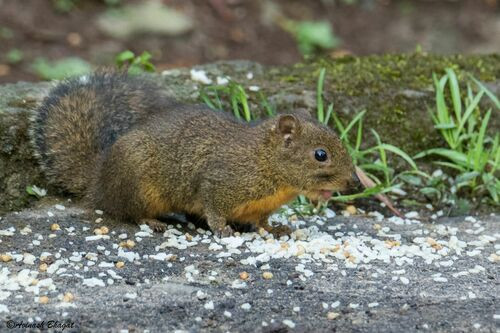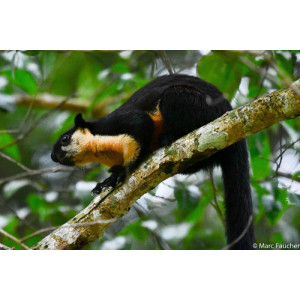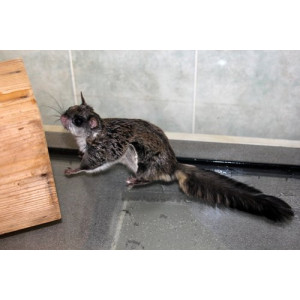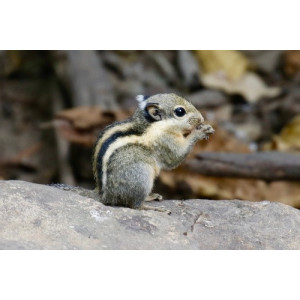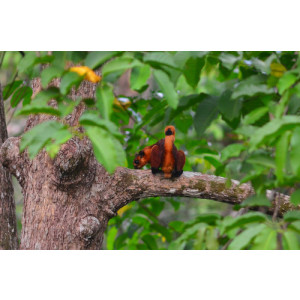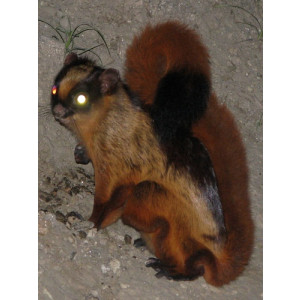Orange-bellied Himalayan Squirrel Did you see this animal?
Scientific Name : Dremomys lokriah
Family : Sciuridae
Order : Rodentia
Class : Mammalia
Phylum : Chordata
Habitat : Forest
Description : The Limestone Rat has a distinctive appearance, with a long, pointed snout, large, rounded ears, and a relatively long, slender tail. They have short, dense fur that ranges in color from gray-brown to reddish-brown. They have large eyes that are well-adapted to the low light conditions found in caves.
These rats are small, with adults typically measuring between 9 and 11 cm in length, and weighing between 30 and 50 grams. They are agile climbers and are capable of scaling vertical surfaces and navigating narrow crevices.
Limestone Rats are nocturnal and feed primarily on insects, although they have also been known to eat small vertebrates and plant matter. They are solitary creatures, with each individual occupying a small territory within the cave system.
One of the most unique features of the Limestone Rat is their ability to navigate in complete darkness. They possess a highly developed sense of touch, using their vibrissae (whiskers) to sense their environment and locate prey. They also have an acute sense of hearing and are able to use echolocation to navigate in the dark.
Limestone Rats have a unique reproductive system. They are able to breed year-round and females can give birth to up to six offspring at a time. The young are born naked and blind and are completely dependent on their mother for several weeks.
As mentioned earlier, the Limestone Rat is found in the limestone caves. These habitats provide the rats with the ideal conditions for survival. They are able to take advantage of the cool and constant temperature within the caves, as well as the abundant food supply of insects.
Dremomys lokriah is considered a vulnerable species due to habitat loss and degradation caused by human activities, such as limestone quarrying and deforestation. Conservation efforts are underway to protect their cave habitats and prevent further decline in their populations.
These rats are small, with adults typically measuring between 9 and 11 cm in length, and weighing between 30 and 50 grams. They are agile climbers and are capable of scaling vertical surfaces and navigating narrow crevices.
Limestone Rats are nocturnal and feed primarily on insects, although they have also been known to eat small vertebrates and plant matter. They are solitary creatures, with each individual occupying a small territory within the cave system.
One of the most unique features of the Limestone Rat is their ability to navigate in complete darkness. They possess a highly developed sense of touch, using their vibrissae (whiskers) to sense their environment and locate prey. They also have an acute sense of hearing and are able to use echolocation to navigate in the dark.
Limestone Rats have a unique reproductive system. They are able to breed year-round and females can give birth to up to six offspring at a time. The young are born naked and blind and are completely dependent on their mother for several weeks.
As mentioned earlier, the Limestone Rat is found in the limestone caves. These habitats provide the rats with the ideal conditions for survival. They are able to take advantage of the cool and constant temperature within the caves, as well as the abundant food supply of insects.
Dremomys lokriah is considered a vulnerable species due to habitat loss and degradation caused by human activities, such as limestone quarrying and deforestation. Conservation efforts are underway to protect their cave habitats and prevent further decline in their populations.
Distribution in Bangladesh
References:
description written by:Asad U. Tanvir,Department of Zoology,Jagannath University,Dhaka; reviewed by:Muntasir Akash,Department of Zoology,University of Dhaka;Taxonomic Checklist:Red List of Bangladesh Volume 2: Mammals, 2015, IUCN; information sources:iucnredlist.org, Khan 2018 (Photographic guide to the wildlife of Bangladesh), photo credit:Samiul Mohsanin, (Jahangirnagar University,Dhaka), photo copyright: Samiul Mohsanin.more information please contact with us.
description written by:Asad U. Tanvir,Department of Zoology,Jagannath University,Dhaka; reviewed by:Muntasir Akash,Department of Zoology,University of Dhaka;Taxonomic Checklist:Red List of Bangladesh Volume 2: Mammals, 2015, IUCN; information sources:iucnredlist.org, Khan 2018 (Photographic guide to the wildlife of Bangladesh), photo credit:Samiul Mohsanin, (Jahangirnagar University,Dhaka), photo copyright: Samiul Mohsanin.more information please contact with us.
